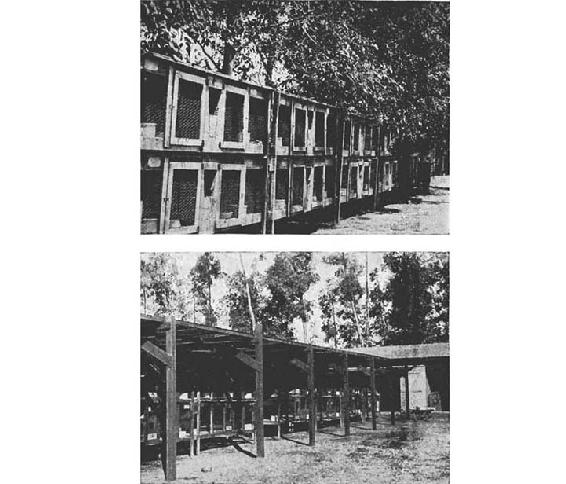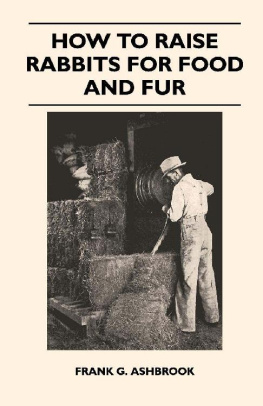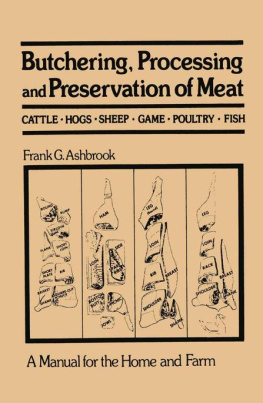HOW TO RAISE
RABBITS FOR
FOOD AND FUR
BY
FRANK G. ASHBROOK
In Charge, Fur Resources,
Fish and Wildlife Service
United States Department of the Interior Chicago, Ill.
ILLUSTRATED


FIG. 1. HEADQUARTERS OF RABBIT EXPERIMENT STATION MAINTAINED BY THE UNITED STATES GOVERNMENT AT FONTANA, CALIFORNIA
PREFACE
THE eating habits of all Americans have been affected by World War II. Meatless days are spreading and radical changes in our menus are taking place. Domestic rabbits are becoming more important in supplying meat in restaurants and in homes. Their value in supplementing the family meat supply or adding to the farm income is widely recognized. This appetizing and nutritious meat is not only releasing other meat for the armed forces and for exportation to our allies, but is supplying variety to the family diet on the home front.
Rabbit production has no objectionable features and requires little space. These animals may be kept in the backyard as well as on the farm. Their hutches can be made of scrap lumber, used poultry wire, crates and similar materials that are obtainable at little or no cost. And as for their food, clean table scraps, truck garden waste, refuse from green groceries, lawn clippings, palatable weeds and small limbs trimmed from fruit trees may be utilized to supplement their regular rations. Rabbit meat is quickly produced as only 90 days are required from the time the doe is bred until the young rabbits are ready for the table.
I owe special acknowledgment to Charles E. Kellogg and George S. Templeton, who have contributed ideas and facts based on research. My debt to Edna N. Sater is noteworthy for suggestions of treatment and arrangement of subject matter, and especially in the chapter, How to Cook Rabbit.
I have reason to be especially grateful to the Fish and Wildlife Service for data obtained from research and for permission to use photographs; and to the Bureau of Plant Industry, Soils, and Agricultural Engineering for working drawings and bills of materials, and to many practical breeders and their associations for supplying information; to the rabbit and fur trade journals for permission to use illustrations.
One other sort of indebtedness calls for recordingthe aid both intangible and in direct cooperation which I have had from Caroline McKinley Ash-brook. There are no words to express the ways and extent of my reliance upon her for help and advice.
F. G. A.
Chicago, Illinois.
CONTENTS
Backyard Rabbitry for Home Consumption |
Market for Rabbit Fur |
Hasty Investments Not Recommended |
Time of Breeding |
Mating |
Experimental Feeding |
Rations for all Classes of Rabbits |
Self-Feeding |
Feed Costs and Profits |
Nurse-Does |
Value of Rabbit Meat |
Analysis of Meat |
Tested Rabbit Recipes |
LIST OF ILLUSTRATIONS
HOW TO RAISE RABBITS FOR FOOD AND FUR
I
RABBIT MEAT FOR THE FAMILY
Important Meat in Food for Freedom ProgramBackyard Rabbitry for Home ConsumptionMarket for Rabbit FurUnited States Rabbit Experiment StationSections of the Country Adapted to Rabbit Raising
HOW TO RAISE RABBITS
FOR FOOD AND FUR
I
RABBIT MEAT FOR THE FAMILY
WORLD WAR II has changed the eating habits of us all because it has brought about shortages of familiar foods. Radical changes in our menus are taking place. Foods that many of us never before considered eating are being featured now in the food columns of our daily newspaper. But, as we all know, to be assured of victory Americans must do without, so that our armed forces and our allies have the necessities to wage war. Rabbit raising is no longer a minor agricultural pursuit but a major project in our national food producing program.
In many sections of the country the consumption of domestic rabbit meat has attained considerable proportions. Markets for the meat are becoming well established and motor trucks make regular trips to rabbitries to pick up animals and deliver them to central slaughter houses. Meat shortages are becoming very acute everywhere in the United States and people have discovered that domestic rabbit provides a most attractive and tasty variation to a meal that otherwise might be meatless.

FIG. 2. A SMALL BACKYARD RABBITRY CAN QUICKLY SUPPLY MEAT FOR HOME CONSUMPTION
).
Prior to World War II rabbit meat was available on the West Coast in butcher shops, chain stores, and was served at road stands, restaurants and hotels. Hospitals also used considerable quantities. Meatless days in California, Oregon, and Washington have become meatless weeks and the demand for rabbit as a replacement meat far exceeds the supply ().
In other parts of the country there are relatively few places where rabbit meat has ever been displayed and regularly offered for sale. There rabbit meat is produced chiefly for home and local consumption and the general public is not well acquainted with the product.
The national emergency has brought about a radical change and domestic rabbit meat has an important place in the Food for Freedom program. The home use of this fine-grained pearly white, and nutritious meat, will not only release other meat for the armed forces and for exportation to our allies, but will supply variety to the family diet on the home front. Rabbit meat is nutritious and palatable and may be served throughout the year. Fryer rabbits weighing 3-3/4 to 4-1/4 pounds when weaned and ready for the market at 2 months of age will yield a carcass, including liver and heart, of 50 to 57 percent of the live weight. Roastersdoes and bucks that have served their period of usefulnesswhen properly conditioned for the market will yield a carcass of 55 to 65 percent.

FIG. 3. MANY SMALL WELL ARRANGED RABBITRIES SIMILAR TO THESE ARE OPERATED IN CALIFORNIA
Rabbit raising has progressed far beyond expectations since meatless days have become meatless weeks and replacement meats are the order of the day. The small rabbitry actually has a serious place in the domestic economy. Its future, however, as one of the important industries of the country, depends mainly upon continued production of food and fur in commercial quantities. World War II will overcome the former obstacle of popularizing the meat, and the production of domestic rabbits will reach its greatest development during the present crisis. People will learn to appreciate the delicately flavored white meat and will overcome any prejudice they may have had to killing and eating animals that by many were considered only as pets. Today, the shortage of meat is becoming so serious that the production of rabbits has become a major replacement meat enterprise.








